Introduction
In Part 1, I described my journey to Birkenhead's Hamilton Square station by train.
Over the years, I'd seen Birkenhead Docks from various viewpoints, but I'd never really studied them. I'm afraid I rather saw them as a 'poor relation' to Liverpool Docks (see my posts Liverpool and The Mersey Docks and Harbour Board). Clearly, I'd left it years too late (and the weather on the day of my visit was deteriorating) but I was determined to see what was left.
The design of Birkenhead's Docks is quite different from Liverpool's Docks. Wallasey Pool was a natural Tidal Inlet which was enclosed to create the docks. After the creation of the earlier, smaller docks, the Great Float was constructed between 1851 and 1860 producing over four miles of quays. The massive construction project overwhelmed the Birkenhead Dock Company and in 1858 the business was taken over by the Mersey Docks and Harbour Board (just across the water). The Great Float was divided into two by a road and rail bridge over the passage for ships. The two parts were named Great West Float and Great East Float. Today, these two bodies of water are simply called West Float and East Float but they still total 110 acres of water. See the Wikipedia article here. The usual tangle of dock railways was developed to serve this complex, as shown on the 1913 Railway Clearing House Plan of Birkenhead Docks below.
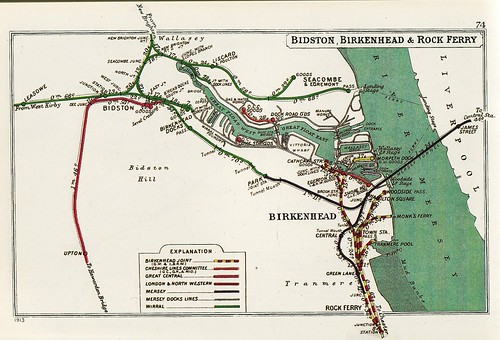 Click here for larger image.
Click here for larger image.Railway Clearing House Plan of Birkenhead Docks 1913.
Before my trip I (correctly) concluded that very little of the dock railway would have survived but I also had another target in view. Ever since I first spotted Scherzer Rolling Lift Bridges in Liverpool's Docks, they've had a fascination for me. The functional design seemed elegant compared with the traditional Bascule Bridge (London's Tower Bridge is probably the best known example). I hoped to look at three Scherzer Rolling Lift Bridges in my perambulation around the docks and, despite the weather, that's what I did.
Hamilton Square Station
I emerged from Hamilton Square Station into a cold, grey morning with rain spitting. I crossed the road to take a picture of the station building with its distinctive tower. It was over 60 years ago when I first saw it, from a Mersey Ferry approaching Woodside Landing stage. Then, as now, the side of the tower facing the river carried the simple slogan: 'HAMILTON SQUARE STATION - FREQUENT ELECTRIC TRAINS'. I'm still impressed.
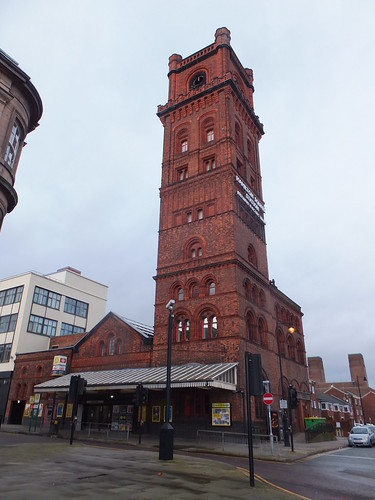
Hamilton Square Station.
I set off along Canning Street, passing the rather handsome Cheshire Lines Committee building which I presume was originally Shore Road Goods Depot, now converted into business units.
Egerton Bridge
Eventually, I came to Egerton Bridge,the first of the Scherzer Rolling Lift Bridges on my list. This bridges the passage between Egerton Dock and Morpeth Dock. Wikipedia describe Egerton Dock here and dates the present bridge to 1928-1931, replacing an earlier swing bridge. Although the bridge was reputedly restored in 1995, it doesn't appear capable of use, nor is it needed as the other exits from both Edgerton Dock and Morpeth Dock have been filled in, leaving an isolated body of water.
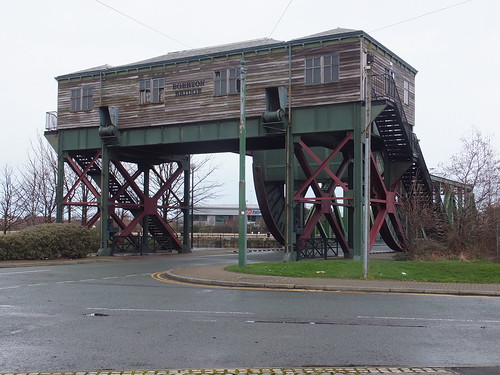 Egerton Bridge, a Scherzer Rolling Lift type.
Egerton Bridge, a Scherzer Rolling Lift type.
Set in the quay, I did find an interesting winch. I can only guess that this may have been part of the mechanism for turning the original swing bridge. The cast side plates are dated and named, but I can't make out the short word after 'DAGLISH'. There were two Robert Daglish, father and son. The son was perhaps the better known - see the Wikipedia article here, but I rather think the hard-to-read word is an abbreviation of 'SENIOR'. Needless to say, the ugly mesh covers are a modern addition.
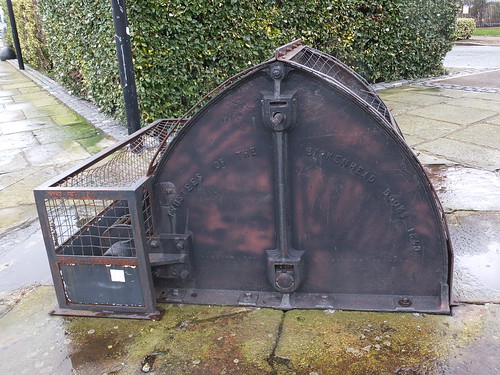 Egerton Bridge: Winch marked 'TRUSTEES OF BIRKENHEAD DOCKS 1850' and 'DAGLISH ... ST HELENS FOUNDRY'
Egerton Bridge: Winch marked 'TRUSTEES OF BIRKENHEAD DOCKS 1850' and 'DAGLISH ... ST HELENS FOUNDRY'
The Central Hydraulic Tower
I retraced my route to the junction where Canning Street becomes Tower Road and followed Tower Road as it turned north to cross the filled-in entrance to Edgerton Dock, pass over what appears to be a fixed bridge and arrived at the building (on the left) which gave the road its name. This is the Central Hydraulic Tower and Engine House completed 1863 which provided power for the lock gates and bridges. It was designed by the remarkable Jesse Hartley (1780 - 1860) who, as Dock Engineer, was responsible for the design and execution of most of Liverpool's docks. Certainly the architectural style is pure Hartley, giving the appearance of an Italian palace (the Palazzo Vecchio in Florence is credited as inspiration). The building was badly damaged by bombing in the Second World War, giving rise to large expanses of modern, undecorated brickwork. The building is now disused and in poor condition.

A Palazzo in Birkenhead: The Central Hydraulic Tower.
Stena Line 12 Quays Terminal
The road access to Stena Line's 12 Quays Terminal is opposite the Central Hydraulic Tower. The old Wallesey Dock has been filled in and is now a huge lorry and car park for vehicles using the Liverpool - Belfast ferry service. The ferries berth in the River Mersey. Ferries MS 'Stena Lagan' and MS 'Stena Mersey' make the crossing in eight hours.
 View of Stena Line's Belfast Ferry Port from Edgerton Bridge with the 'Three Graces' and Liverpool Museum in the background.
View of Stena Line's Belfast Ferry Port from Edgerton Bridge with the 'Three Graces' and Liverpool Museum in the background.
Tower Road Bridge
This large rolling lift bridge retains flashing lights and lifting barriers on the approach road either side and must be in occasional use. It bridges the 100 foot wide channel which is now the only route between the River Mersey and the Float.
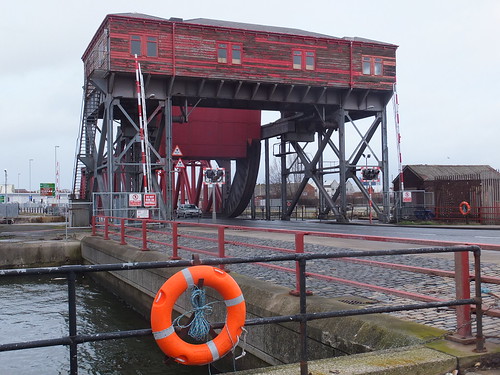 Tower Road Lifting Bridge.
Tower Road Lifting Bridge.
Canning Street Signal Box
Again, I retraced my route to the junction with Rendel Street, which I knew was crossed by the double-track main dock line at a level crossing. In steam days, freight from the L.M.S. - G.W.R. joint line for the docks passed through Haymarket Tunnel and was split between Canning Street North and Canning Street South at Brook Street signal box. I found the remains of Canning Street North signal box, with serious fire damage, next to the former level crossing which had been covered with tarmac. As befits a dock line, the gates were hand worked, made of metal. It must have once been a busy place, because the skeleton of a pedestrian overbridge still crossed the double track.
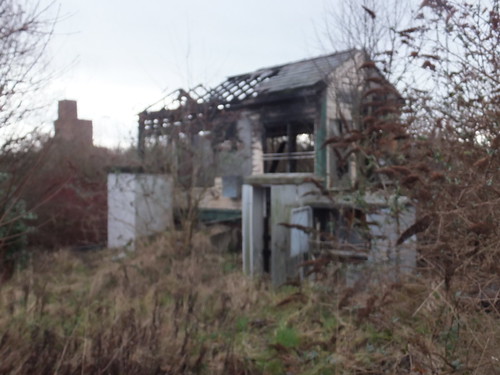 A fuzzy view of the rear of Canning Street North signal box.
A fuzzy view of the rear of Canning Street North signal box.
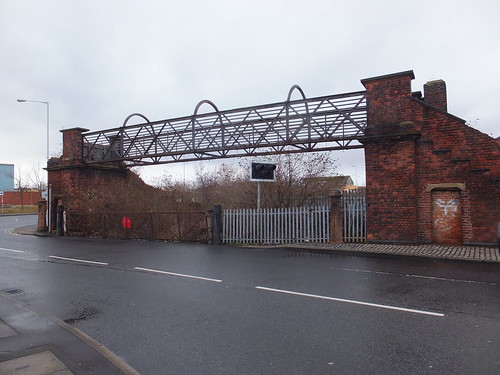 The former level crossing at Canning Street North and pedestrian overbridge,
The former level crossing at Canning Street North and pedestrian overbridge,
Duke Street Bridge
I turned west onto Corporation Road, separated from the dock estate by a tall, old dock wall. All the old dock buildings had been removed, replaced by large modern factory and warehouse buildings still in use. Having walked the length of the Eat Float, I turned north onto Duke Street with its large rolling lift bridge across the 100 foot wide channel which divides the West and East Floats. Again, this bridge sees occasional use. Despite the poor weather, I managed a few photographs.
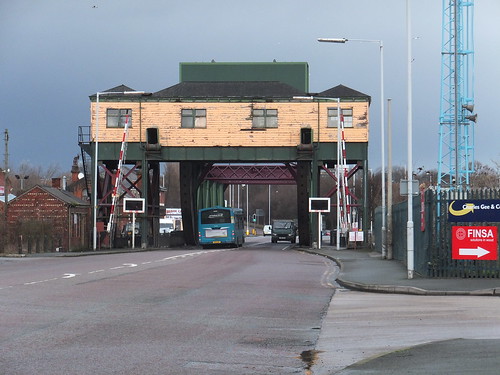 Duke Street Bridge towers over a single deck bus.
Duke Street Bridge towers over a single deck bus.
I found Mersey Ferries 'Royal Iris' and 'Royal Daffodil' laid-up, presumably during 'low season', in the East Float adjacent to Duke Street Bridge.
 Mersey Ferries 'Royal Iris' and 'Royal Daffodil' adjacent to Duke Street Bridge.
Mersey Ferries 'Royal Iris' and 'Royal Daffodil' adjacent to Duke Street Bridge.
At the north end of the bridge, I was surprised and pleased to find a cafe. There was just time for a snack before they closed (half past twelve on a Saturday, apparently).
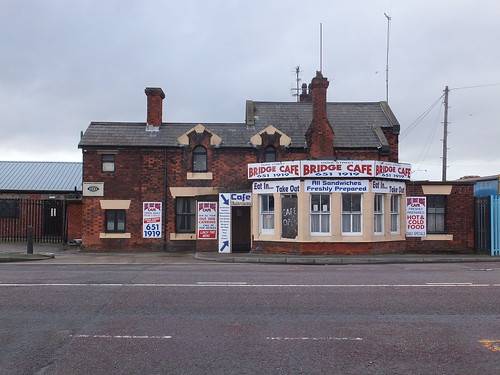 The appropriately-named 'Bridge Cafe'.
The appropriately-named 'Bridge Cafe'.
Just at the south end of the bridge, there were a pair of Canada geese resting on the quay. Then didn't object when I went to photograph a wagon turntable in surprisingly good condition.
 Wagon Turntable adjacent to Duke Street Bridge.
Wagon Turntable adjacent to Duke Street Bridge.
Bidston Graving Docks
I made my way back to Corporation Road and continued walking west. The dock wall had finished and the double track dock line no ran along the verge of the road, very overgrown. I turned into Beaufort Road where the dock area on the right has been cleared, probably as part of the West Float Remediation Project. This is part of very ambitious schemes by Wirral Waters and the Peel Group but there wasn't much sign of recent progress. I was surprised to find that the dock railway lines here were flat bottom but they'd been torn up in places, as if some giant had tired of his toy trains and ripped up the tracks. All a bit puzzling. There were once three graving docks here but I think only number 3 survives. This is part of the Cammell Laird ship repair site. Three ships could be seen:-
'Gold Rover': Small fleet tanker of the Royal Fleet Auxiliary Service. Information on Wikipedia here or on the Royal Navy site here.
'Fort Rosalie': Fleet replenishment ship of the Royal Fleet Auxiliary Service. Information on Wikipedia here or on the Royal Navy site here.
'Key Fighter': Oil/Chemical tanker, probably loading/discharging at the tank farm on the North Quay. Some information here.
 Cammell Laird's yard in the West Float showing (l to r) 'Gold Rover, 'Fort Rosalie' and 'Key Fighter'.
Cammell Laird's yard in the West Float showing (l to r) 'Gold Rover, 'Fort Rosalie' and 'Key Fighter'.
There is a modern swing bridge in Wallesey Bridge Road but I didn't inspect it. It divided the West Float from Wallesey Pool but Wallesey Pool has been filled in so the bridge is no longer operational.
It was still raining intermittently, so I was happy to make my way across to Birkenhead North Station for a trip to New Brighton, described here.
Related articles on other sites
Scherzer Rolling Lift Bridges (1906 catalogue).
Cammell Laird
Robert Daglish
Jesse Hartley
The Great Float.
Related posts in this blog
Birkenhead and New Brighton by train (Part 1)
Birkenhead and New Brighton by train (Part 3)
My pictures
Merseyrail.
Birkenhead and its Docks.
